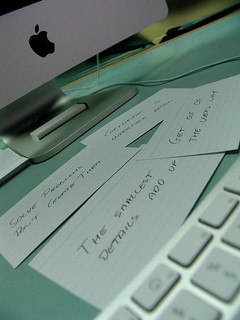
Speaker: Steven Sowell
His position is new for his library (July 2011), and when Barbara Fister saw the job posting, she lamented that user-centered collection development would relegate librarians to signing licenses and paying invoices, but Sowell doesn’t agree.
Values and assumptions: As an academic library, we derive our reason for existing from our students and faculty. Our collections are a means to an end, rather than an end to themselves. They can do this in part because they don’t have ARL-like expectations of themselves. A number of studies has shown that users do a better job of selecting materials than we do, and they’ve been moving to more of a just in time model than a just in case.
They have had to deal with less money and many needs, so they’ve gotten creative. The university recently realigned departments and positions, and part of that included the creation of the Collections & Resource Sharing Department (CRSD). It’s nicknamed the “get it” department. Their mission is to connect the community to the content.
PDA, POV, PPV, approval plans, shelf-ready, and shared preservation are just a few of the things that have changed how we collect and do budget planning.
CRSD includes collection development, electronic resources, collections management, resource sharing & delivery, and circulation (refocusing on customer service and self-servicing, as well as some IT services). However, this is a new department, and Sowell speaks more about what these things will be doing than about what they are doing or how the change has been effective or not.
One of the things they’ve done is to rewrite position descriptions to refocus on the department goals. They’ve also been focusing on group facilitation and change management through brainstorming, parking lot, and multi-voting systems. Staff have a lot of anxiety over feeling like an expert in something and moving to where they are a novice and having to learn something new. They had to say goodbye to the old routines, mix them with new, and then eventually make the full shift.
They are using process mapping to keep up with the workflow changes. They’re also using service design tools like journey mapping (visualization of the user’s experience with a service), five whys, personas, experience analogy, and storyboards (visualization of how you would like things to occur).
For the reference staff, they are working on strategic planning about the roles and relationships of the librarians with faculty and collections.
Change takes time. When he proposed this topic, he expected to be further along than he is. Good communication, system thinking, and staff involvement are very important. There is a delicate balance between uncertainty/abstract with a desire for concrete.
Some unresolved issues include ereaders, purchasing rather than borrowing via ILL and the impact on their partner libraries, role of the catalog as an inventory in the world of PDA/PPV. The re-envisioning of the collection budget as a just in time resource. Stakeholder involvement and assessment wrap up the next steps portion of his talk.
Questions:
In moving print to the collection maintenance area, how are you handling bundled purchases (print + online)? How are you handling the impression of importance or lack thereof for staff who still work with traditional print collection management? Delicately.
Question about budgeting. Not planning to tie PDA/PPV to specific subjects. They plan to do an annual review of what was purchased and what might have been had they followed their old model.
How are they doing assessment criteria? Not yet, but will take suggestions. Need to tie activities to student academic success and teaching/researching on campus. Planning for a budget cut if they don’t get an increase to cover inflation. Planning to do some assessment of resource use.
What will you do if people can’t do their new jobs? Hopefully they will after the retraining. Will find a seat for them if they can’t do what we hope they can do.
What are you doing to organize the training so they don’t get mired in the transitional period? Met with staff to reassure them that the details will be worked out in the process. They prepared the ground a bit, and the staff are ready for change.
Question about the digital divide and how that will be addressed. Content is available on university equipment, so not really an issue/barrier.
What outreach/training to academic departments? Not much yet. Will honor print requests. Subject librarians will still have a consultative role, but not necessarily item by item selection.
